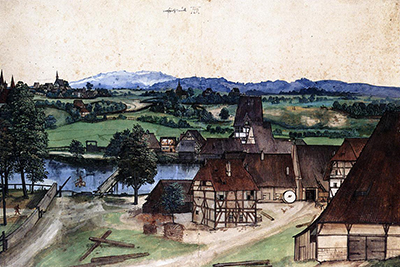Albrecht Durer created the Wire Drawing Mill in the summer of 1494. This painting was amongst his first watercolours. It is famous and found to be remarkable for the composition and the control in perspective. This is considered given the date and time in which it was created.
Albrecht Durer’s painting would have passed for a 19th-century view instead of its dated time. Having been among his earliest pieces of art, Wire Drawing Mill was created when the artist was at an early age. The sketches in the image are vital and immediate. It illustrates a workshop that made copper wire, and this is where the name of the painting originated. The view of the image is aerial, with views over the large and small mills. The mills are located in the meadows along the river Pegnitz that all belonged to the city of Nuremberg. There are the Grossweiden Mill buildings in the foreground located on the bank of the River Pegnitz towards the north. This is near the St John's Church. To add to the details that Albrecht Durer illustrated, a mill wheel can be seen leaning against a building. The Kleinweiden Mill is on the farthest side of the water body.
Mountains are seen in the background with villages that are on the outskirts of Nuremberg. The houses are German because of the roofs that come to a point and the choice of colour - dark brown and the wooden accent that make them even more attractive. He focused on the details, and the effect was a realistic masterpiece. The whole picture has the Netherlands feel resulting from the various tones that have been used. The brown tones are seen in the foreground, the greens representing the grass and trees in the middle ground, and the shade of blue used for the mountains in the distance. The general effect was achieved with thinned watercolours with freer brushstrokes that incorporate the subtle browns, beiges, greens, and blues.
One of the key themes in this piece is of humans being dwarfed amid nature. The human walking on the road and the one in the river cannot be compared to the vast landscape. Albrecht Durer’s inspiration for this piece was a simple, down-to-earth illustration of a landscape. The visualization of the images in the location is precise and can still be recognizable today. This was after he had returned from his journey to Basel, Colmar, and Strasburg. The Wire Drawing Mill signals the growth of German landscape paintings and a varied collection of landscape water paintings by Albrecht Durer.




